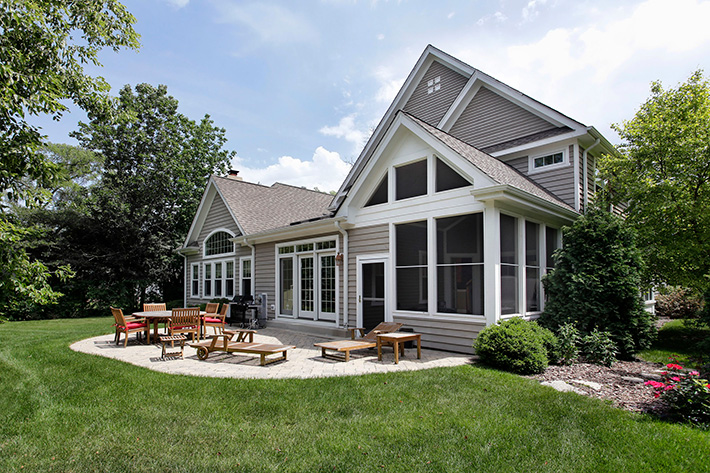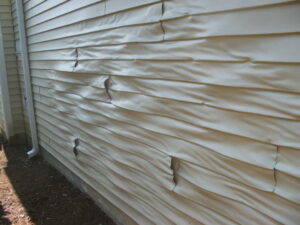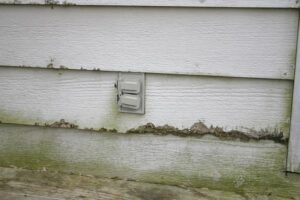
Your home deserves to make a lasting impression, but worn-out siding can quickly dampen its curb appeal. As a homeowner, it’s crucial to be proactive and recognize the warning signs that indicate when it’s time to replace your siding. Whether you’re dealing with faded vinyl, deteriorating fiber cement, or aging aluminum siding, understanding these signs will help you take the necessary steps to maintain your home’s beauty and protect its structural integrity. In this comprehensive guide, we’ll explore the warning signs of siding replacement and provide valuable insights for optimizing your home’s exterior. Get ready to elevate your home’s aesthetics and safeguard its value!
Warning Signs of Siding Replacement: Is It Time to Update Your Home Exterior?
Your home is your sanctuary, and it’s important to ensure that every part of it is in good condition, including the siding. Siding, also known as wall cladding, plays a crucial role in protecting your home’s exterior from the elements. Over time, however, siding can deteriorate and require replacement. In this comprehensive guide, we’ll discuss the warning signs that indicate it’s time to replace the siding on your home, with a focus on three popular siding materials: vinyl siding, fiber cement siding, and aluminum siding. By understanding these signs, you can take proactive steps to maintain the integrity and beauty of your home.
Warning Signs for Vinyl Siding Replacement:
Vinyl siding is a popular choice for many homeowners due to its durability, affordability, and low maintenance requirements. However, even vinyl siding can show signs of wear and tear that warrant replacement. Here are the warning signs to look out for:

- Fading and Discoloration: Over time, exposure to sunlight can cause vinyl siding to fade or develop uneven discoloration. If you notice significant color changes or a dull appearance, it may be time to consider replacing the vinyl siding. New vinyl siding options offer improved UV resistance and color retention, ensuring a long-lasting and vibrant exterior for your home.
- Warping and Buckling: Vinyl siding that has warped or buckled may indicate underlying moisture issues. This can occur due to poor installation, water infiltration, or excessive heat exposure. Warped or buckled siding not only affects the visual appeal of your home but also compromises its ability to protect against the elements. In such cases, it’s best to consult a professional siding contractor to assess the extent of the damage and determine if replacement is necessary.
- Cracks and Breaks: Cracks or breaks in vinyl siding can occur due to impact damage, extreme temperature changes, or aging. These openings allow moisture to seep behind the siding, leading to potential water damage and mold growth. If you notice cracks or breaks in your vinyl siding, it’s crucial to address the issue promptly to prevent further deterioration and protect the structural integrity of your home.
Warning Signs for Fiber Cement Siding Replacement:
Fiber cement siding is known for its durability, resistance to insects and rot, and its ability to mimic the appearance of wood or masonry. However, like any siding material, fiber cement siding can exhibit signs of wear that may require replacement. Here are the warning signs to watch for:
- Moisture Damage: Fiber cement siding is highly resistant to moisture, but it is not immune to water damage. If you observe signs of water infiltration, such as swelling, cracking, or rotting, it’s crucial to address the issue promptly. Moisture damage can compromise the structural integrity of the siding and lead to more significant problems, such as mold growth and wood decay.
- Cracking or Chipping: Cracks or chips in fiber cement siding can occur due to impact, excessive movement, or aging. These imperfections can allow moisture to penetrate the siding, leading to potential water damage and compromising its overall performance. If you notice significant cracks or chips, it’s advisable to consult a professional siding contractor to evaluate the extent of the damage and recommend the appropriate course of action, which may involve replacing the affected sections or the entire siding.
- Excessive Peeling or Fading Paint: Fiber cement siding is often pre-painted or factory-finished, providing long-lasting color and protection. However, if you observe excessive peeling or fading of the paint, it may indicate underlying issues with the siding. This can include improper installation, moisture problems, or the natural aging of the paint. Replacing the affected siding or repainting the entire surface may be necessary to restore the aesthetic appeal and protective properties of the siding.
Warning Signs for Aluminum Siding Replacement:
Aluminum siding has long been a popular choice for its affordability, lightweight nature, and resistance to fire and pests. However, even aluminum siding can experience wear and tear over time. Here are the warning signs that may indicate the need for aluminum siding replacement:
- Dents and Damage: Aluminum siding is susceptible to dents and damage, particularly from hailstorms, falling branches, or other impact events. While minor dents may not require immediate replacement, significant damage can compromise the overall appearance and structural integrity of the siding. If you notice extensive dents or damage, it’s advisable to consult a professional siding contractor to assess the situation and determine the best course of action.
- Corrosion and Oxidation: Over time, aluminum siding may develop corrosion or oxidation, especially in areas with high humidity or exposure to saltwater. Corrosion can cause the siding to become weak, leading to potential water infiltration and structural issues. If you observe signs of corrosion, such as pitting or a powdery residue, it’s essential to address the problem promptly to prevent further deterioration and maintain the integrity of your home’s exterior.
- Fading or Chalking: Fading or chalking of the paint on aluminum siding is a common issue as it ages. This can result in a dull or chalky appearance, detracting from the overall curb appeal of your home. While repainting can restore the siding’s appearance temporarily, extensive fading may indicate that it’s time to consider replacing the aluminum siding to ensure a fresh and vibrant look for your home.
Specific Signs for Wood Siding Replacement:
Wood siding adds a classic and timeless charm to homes, but it requires regular maintenance to stay in good condition. Here are some warning signs that indicate the need for wood siding replacement:

- Rot and Decay: Wood is susceptible to rot and decay when exposed to moisture for extended periods. Inspect your wood siding for signs of rot, such as soft spots, discolored areas, or wood that crumbles easily when touched. Rot can spread quickly and compromise the structural integrity of your home, so it’s crucial to address it promptly. If you notice widespread rot or areas where the wood has become spongy or weak, it’s a clear indication that replacement is necessary to prevent further damage.
- Insect Infestation: Wood siding is a prime target for insects, such as termites and carpenter ants, which can cause significant damage if left unchecked. Look for signs of insect activity, such as small holes, sawdust-like debris (frass), or the presence of winged insects around your wood siding. If you suspect an infestation, consult a professional exterminator and a siding contractor to assess the extent of the damage and determine if replacement is required. If you find extensive termite tunnels or evidence of carpenter ant colonies within your wood siding, replacement is often the best course of action to ensure the structural integrity of your home.
- Splitting and Cracking: As wood ages, it can develop splits and cracks due to moisture absorption, temperature changes, or natural expansion and contraction. While some minor splitting and cracking may be normal, extensive or deep splits can compromise the effectiveness of your wood siding. Inspect your siding for large or widening cracks, especially in areas exposed to direct sunlight or frequent moisture. If you notice significant splits that extend through the wood or gaps that allow water infiltration, it’s important to consider replacement to prevent further damage and maintain the visual appeal of your home.
- Peeling or Flaking Paint: Paint serves as a protective barrier for wood siding, preventing moisture penetration and decay. If you notice peeling or flaking paint on your wood siding, it’s a sign that the protective coating has deteriorated, leaving the wood vulnerable to moisture damage. Repainting may be a temporary solution, but if the wood beneath the paint is compromised or if peeling occurs repeatedly, replacement is often the best long-term option. If you observe large areas where the paint has peeled away, exposing the bare wood or signs of multiple paint failures, it’s an indication that replacement is necessary to maintain the integrity and appearance of your home.
Conclusion:
Being aware of the warning signs that indicate the need for siding replacement is crucial for maintaining the structural integrity, energy efficiency, and aesthetic appeal of your home. Whether you have vinyl siding, fiber cement siding, or aluminum siding, paying attention to these signs and consulting with professional siding contractors will help you make informed decisions about when it’s time for an update. Remember, a well-maintained and attractive exterior not only enhances your home’s curb appeal but also protects it from the elements for years to come. Invest in quality siding and proactive maintenance to ensure the longevity and value of your home.
For reliable siding replacement and installation services, look no further than 180 Contractors. Our experienced team specializes in various siding materials, including vinyl, fiber cement, and aluminum, ensuring that your home’s exterior is in expert hands. Contact us today for a free estimate on siding, roofing, windows, & more. Let us help you transform your home 180 degree’s with high-quality siding solutions.
